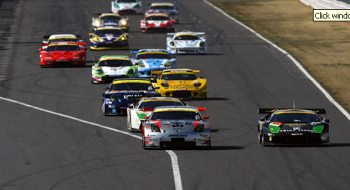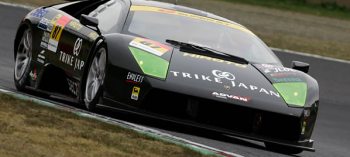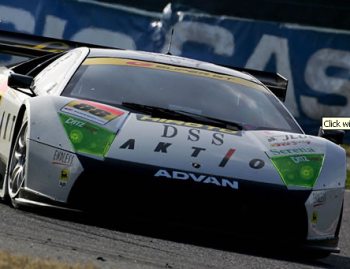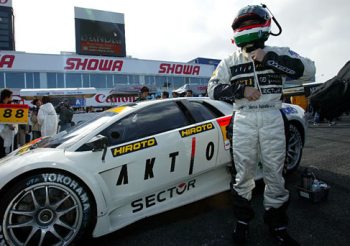|
The historic first-ever
victory for the Lamborghini Murciélago RG-T, in last
weekend's Suzuka 300km, came courtesy of
Team JLOC, a small, dedicated band of Japanese Lamborghini
enthusiasts.
The story of Team JLOC on the track starts back in the early
1990s. Teruaki Terai, a JLOC member and a designer of racing
cars, decided to participate racing with Lamborghini car
although he didn't have a racing car or sponsors. In 1993,
he acquired a fire-damaged Lamborghini Countach. He and a
friend, M. Mearashi, a former car magazine editor, had
planned to enter JGTC starting inn 1994. Their plan was to
reinforce the burnt chassis and using a mono -plastic body.
By spring of 1994 though, the new race car was still not
completed. They couldn't enter the opening race at Fuji, but
the news of participation of Lamborghini Countach in the
JGTC race attracted the organizer's attention, and they were
requested to enter Fuji race. Then Mearashi invited Satoshi
Ikezawa, a cartoonist and racing driver, and he negotiated
with Art Sport to supply a racing car. Mr. Terai obtained a
famous driver in Takao Wada, and sponsor, Rain X.
Art Sport supplied a road-going Countach. The car was very
heavy, quite unsuitable racing even after removing the
interior. Moreover the engine, clutch, transmission and
differential were of normal specifications. The only
modifications were to the brake and the race specification
wheels. The car was now ready to race. They invited Isao
Noritake, the Chairman of the JLOC, to be the sole director
and the team structure was quickly established. The new team
participated all five races of the 1994 season with director
Terai and drivers Wada and Ikezawa. The car finished two
races.
The team then decided to move forward a stage and develop
the fearsome Diablo, Lamborghini's road successor to the
Countach, into a full racing car.
Mr. Terai did his utmost to move the project forward, even
though he was now suffering from a serious disease, while Naotake
Tamura sponsored the building cost of the new car. In March 1995, the
race car, which was christened the Diablo
Jota was completed, and was able to participate the Japanese GT
Championship right from the
first race. Sadly though Terai died from cancer on August 1995.
In its first season of racing (1995) the Diablo Jota
completed four races out of the
five races in the series, while the next year the team finished two
of the five races.
The team then decided it was time to develop their next race car.
In 1997, Hisashi Wada succeeded
Ikezawa and raced alongside Wada. The car they used was the newly
developed Diablo GTR which featured a Hewland sequential
6-speed gearbox fitted to the engine. However they were only
able to finish two of the five races due to continual
problems with the new gearbox.
|
 |
|
The Kichouhouzan Nissan Z in the hands of Kota Sasaki lost
the GT300 leading position at the GT300 class green light in
Suzuka last weekend with the lead
being snatched by two Lamborghini Murciélago RG-1s, the
No.87 Trike-sponsored car which had been started by Koji
Yamanashi, leading the no 88 Akito-backed example, driven by
Marco Apicella. |
|
 |
|
Rounding out an excellent day for the Murciélago R-GT,
the no 88 Team JLOC entry, driven by Koji
Yamanishi and Wada-Q finished, was classified fifth in GT300
although it retired on the final lap. At this point it had
been lying in second place with the team cruising towards a
1-2 finish. |
|
|
 |
|
The Lamborghini Murciélago claimed its first ever
race win at the weekend when Marco Apicella and
Yasutaka Hinoi (above) raced to victory in the GT300
class of the Japanese Super GT series at Suzuka. |
|
 |
|
Team JLOC has
participated in the Japanese GT Championship since the
inauguration of the series back in 1994, and the
Suzuka 300km was the team's
first - richly deserved - win. It is also the first win in
the world for the Lamborghini Murciélago sportscar. |
|
|
Highlight of the 1997 season was a ninth place finish in the first race
heat of the 'All Star
Race' at the Twin Motegi Ring circuit, the car briefly
showing a glimpse of its speed. The next year Naohiro Furuya
replaced Wada in the cockpit while Shunichi Funaki became a
director. The car was greatly modified and renamed as the
Diablo GT1. The team finished all six JGTC races, with ninth
position being their best result. In 1999, the team
organization remained pretty much the same as the previous
year and
the team finished four out of seven races. The team claimed
twelfth position
after having serious problems with the car in the 'All Star
Race' held at
Autopolis circuit.
For 2001, a new car named the Diablo JGT-1 was debuted by
Team JLOC in the JGTC with Naohiro Furuya and former F1 driver Marco Appicella
as the drivers. Isao Noritake, prominent team owner, was
appointed as a director
and a Tsunetoshi Terai (brother of the late Mr. Teruaki Terai,
the team's founder) came in as chief mechanic. After several
further seasons with the Diablo JGT-1, in 2004 Team JLOC replaced
it with the brand new
Murciélago RG-T which had been developed in conjunction with
the factory and Reiter Engineering. It arrived just in time
to take part practice for round 5 of the Japanese GT Series
at Sugo in May, but a lack of spare parts mean the car had
to be withdrawn. A second Murciélago R-GT, belonging to
Malaysian outfit Amprex Motorsports, arrived in the series
very briefly, but the inability of the car to compete with
the Japanese GT500 teams saw Amprex swiftly depart the scene
while Team JLOC plodded on at the back of the grid with only
another European machine, the Prodrive-built Ferrari 550
Maranello for company.
Last year Team JLOC, who harbour ambitions of competing in
the Le Mans 24 Hours, entered two Reiter
Engineering-supported cars in the Monza 1000kms, a round of
the Le Mans Endurance Series. This year the Murciélago RG-1
(as it is called by Team JLOC) was homologated into the
smaller Super GT class known as GT300, instantly turning the
car into a highly competitive proposition.
|
|
|
|
![]()
![]()